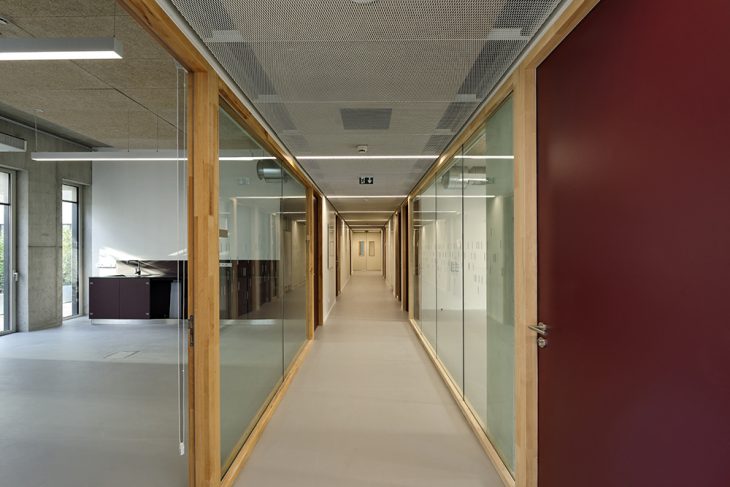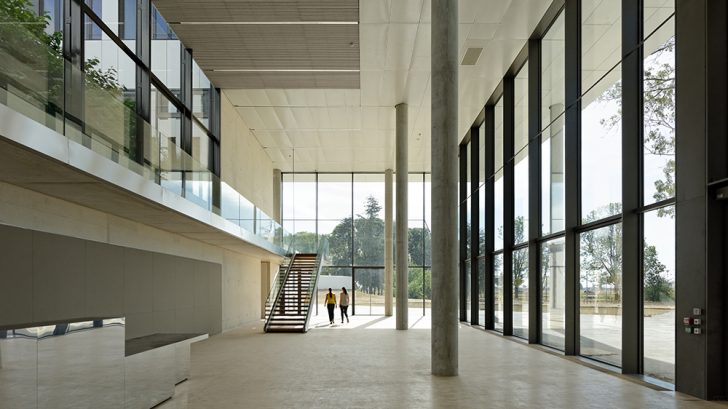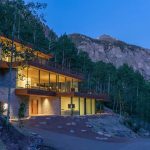
Dietmar Feichtinger Architectes teamed up with Celnikier & Grabli Architectes and Ingerop Conseil & Ingénierie to design the Institute for Neuroscience at the Plateau de Paris-Saclay. The new four-story building provides optimal living, research and working conditions for 350 scientists, 40 students and the laboratory animals in the basement and on the ground floor. Discover more after the jump.

From the architects: The “Plateau de Paris-Saclay” is the upcoming major elite university campus in France. It is the French answer to American universities such as Columbia and Harvard. Situated twenty kilometers south of Paris an international center for technological research is being built on this campus. Over the long term, nearly three thousand billion euros have been earmarked for this purpose.The CEA (Commissariat à l’énergie atomique) is a leading research institution in the fields of energy, environment technology and health. In 2013, it has announced an invited competition for a neuroscience institute for about 350 scientists and 40 students. 59 offices applied, and the winning project was designed by Dietmar Feichtinger Architectes, the lead team, together with Celnikier & Grabli Architectes. The building was delivered in March 2020.


Technology and well-being
“It was a challenge to ensure constantly controlled conditions for scientific research,” explains architect Dietmar Feichtinger “and at the same time to create spatial qualities including natural daylight, fresh air and a relationship with the surroundings. We managed to fulfil both aspects with equal priority”. The required areas – research, laboratories, offices, foyer, and auditoriums – are subject to various access restrictions, which result from the coherent organization itself. Three incised and accessible inner courtyards and transparent bridges create work and laboratory spaces lit by daylight, as well as the informal communication areas essential for modern research.

Distorted perception
Surrounded by trees, the Institute of Neurosciences is close to the CEA’s atomic research, which will create synergies. “We wanted to preserve the trees in order to fit the auditorium into the landscape of the campus park and at the same time create a public space” explains Dietmar Feichtinger. The low, triangular-shaped entrance rises to the south of the four-story cubic building, which is 95 meters long and 50 meters wide. It frames a forecourt with a water basin, which follows the axes of the neighboring research buildings. The roof of the entrance building tapers slightly upwards. Its underside, made of polished stainless steel, reflects the environment in a seemingly distorted perspective. Depending on the angle of view and daylight, it appears different. The changing perception accompanies the path to the entrance of the institute. It is located between the auditorium and the foyer. The polished stainless steel is reflected in the reception area, a single flight of stairs leads to the gallery on the first floor. Eight meters of room height, corner glazing and oak parquet flooring create a welcoming foyer that also provides access to the auditorium and seminar rooms. This is the Institute’s calling card and its interface with the public: events can be organized in this space, which extends to the forecourt through wide opening glass doors.

The central part for research
A facade of concrete panels and narrow glass slits surrounds the research area behind it. The functioning of neurons is studied on living organisms such as fish. These are kept in aquariums under constant conditions (water temperature, light). This applies to all laboratories with animals. The architects have concentrated these strictly regulated areas, with their high technical requirements, on the ground floor and the basement. They form the core of the institute: a schematic circuit of the corridors with aquariums, enclosures, and laboratories. Perfect details, coordinated with material and function, characterize the work of Feichtinger Architectes. They were indispensable for this building. The white, seamless machine room for neurological research seems almost abstract – a separate technical floor was incorporated for its operation. A loading area at the back is used for the delivery of animal feed, living organisms and waste collect. Spatial requirements are constantly changing: a supporting structure made of reinforced concrete allows the various entities to be reprogrammed as required.



An optimal workplace and research space
About 350 scientists work on the upper levels. Open rooms with plenty of daylight, beautiful views and generous circulation areas invite for exchange and create optimal working conditions. Informal communication is the basis for scientific innovation. Three inner courtyards with greenery and sun terraces serve as open controlled outdoor spaces. This is where people like to spend time and meet each other. These courtyards also provide natural light for the offices and laboratories in the depth of the building. Low window parapets of 70 cm enforce the natural light. Open installations run along the exposed concrete ceiling. The offices are equipped with wood fiber based soundproofing panels on the ceiling, welcoming light grey rubber floors. The walls on the corridor side are partially made of glass. This creates a friendly and transparent atmosphere. Here too, flexibility is maximized. “We can transform offices into laboratories and laboratories into offices,” says Feichtinger. The grid, load-bearing access cores and lightweight construction walls make this possible.
RELATED: FIND MORE IMPRESSIVE PROJECTS FROM FRANCE
The three levels are clearly structured: Along the horizontal window stripes of the facade made of metal panels towards the courtyards and opal glass panels towards the outside, the offices and laboratories are aligned along a bright central corridor, from which two further corridors run at right angles. These corridors are connected by glass walkways to the offices and laboratories opposite. “The building is very efficient,” says Feichtinger. “The walkways create short connecting paths.” The interwoven wings with the footbridges divide the open interior space into three courtyards. Approximately 15 meters wide and 24 meters long, they move diagonally through the volume of the building, slightly offset from each other. Thus, they respond to the different depths of the office areas, create individual locations, and allow to explore the building via the open spaces. “People who are researching here should meet each other – that’s why we have attractive outdoor patios, where you can also work of course”, says Dietmar Feichtinger. The access areas are very attractively designed. Through the glazed walkway you can see the yards, the wide staircases and the galleries. “You’re not necessarily supposed to wait for the lift, you’re invited to walk up the stairs.”
As Dietmar Feichtinger stated: “Ensuring constantly controlled conditions for scientific research was a technical challenge. We also wanted to create spatial qualities such as natural daylight, fresh air, and a relation to the surrounding. We fulfill both aspects with equal priority”.

Client CEA Commissariat à l’énergie atomique et aux énergies alternatives
Architects Dietmar Feichtinger Architectes, mandatory Celnikier & Grabli Architectes, associated architects
Competition winner 01 | 2014
Start of planning 06 | 2014
Start of site 04 | 2016
Completion 03 | 2020
Find more projects by Dietmar Feichtinger Architectes: Dietmar Feichtinger Architectes



